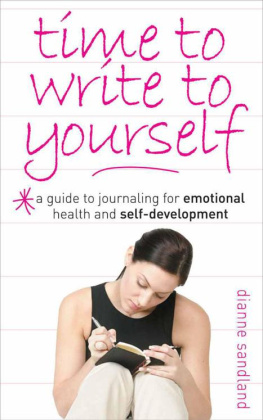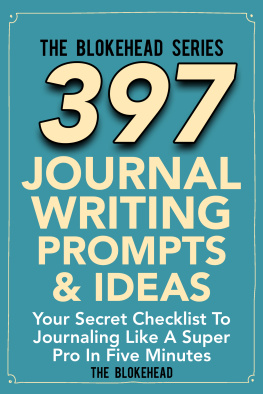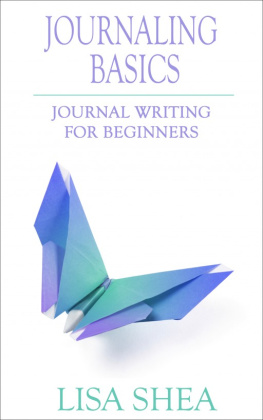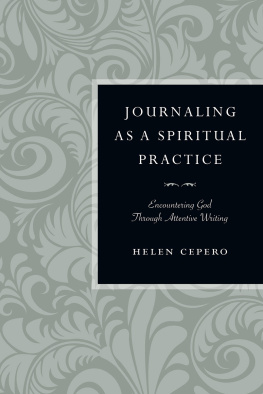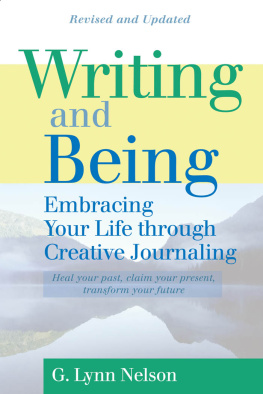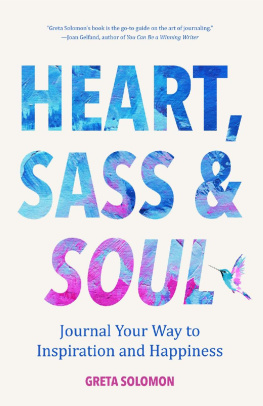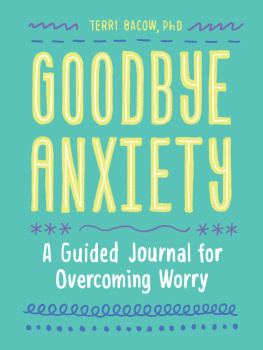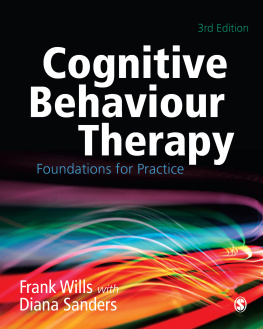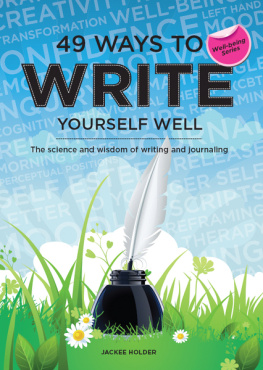
Table of Contents
Dedication
To those who have made my path through life more difficult than it needed to have been, thank you. Without you this book would never have been written and I would never have developed the strength of character I needed not only to survive life but to positively thrive.
To those permanent threads in my life, sometimes at the front of my tapestry and sometimes on the reverse, but always part of the weave, I thank you from the depths of my soul. And if, inadvertently, I have caused you bad times along the way, I apologise.
Disclaimer
If you are suffering from severe emotional pain that is not related to a recent traumatic experience or that has continued for some time with no improvement, you must see a medical practitioner. If you are on medication for your emotional pain, whilst there is no reason for you not to do the exercises in this book (in fact they may be extremely useful to you), it is essential that you continue to take any medication as prescribed. Nothing in this book is designed to take the place of advice from a registered medical practitioner.
How to Use this Book
Writing a journal can help you to understand the past, deal with the present and look forward positively to the future. This book is designed to help you learn some of the techniques of journal writing and thus work towards changing your life for the better.
I didn't write this book in the order it is presented here and you don't need to read it in that order either - although you can if you wish; you are, after all, the master of your own destiny, an idea that is the crux of many of the exercises you will find within these pages. Each of the chapters can stand alone, so if a particular issue resonates with you, then I suggest you go straight to that part of the book and start working on the relevant exercises.
Many of the exercises are based on two of the so-called 'talking therapies': Cognitive Behaviour Therapy (CBT) and Rational Emotive Behaviour Therapy (REBT). It is this combination of therapeutic journaling, CBT and REBT that makes this book different from others that you may find on the subject.
Rather than repeat myself in every chapter, I have included chapters on therapeutic writing and talking therapies in which I explain how these underpin the exercises. By understanding the basics of the talking therapies, in particular, you could devise your own writing exercises specific to the situation in which you find yourself. In this way, the information you find in this book can be adapted to any situation.
If you are new to keeping a journal, see Chapter 6, which explains what you need, why you need it and where to get it. Basically, though, if you've got a pen and paper to hand, you can start right now.
In the Resources section at the back of the book, you will find templates for the journaling processes most often used in the exercises. You can photocopy these templates, write on them directly and then stick them in your journal (you'll need to enlarge them to give yourself enough space for writing if you choose to do this) or if you prefer, you can refer to them as prompts when you are writing in your journal. My preference would be for the second method so that you are not imposing limits on how much you write under each heading.
Finally, you will find that in some places I have used 'he' whilst, in others, I have used 'she'. These are all interchangeable. I was very conscious that I didn't want to direct the book at one gender in particular. Journaling works for everybody.
1
Introduction to Journaling
Stillbirth, child abuse and raising an autistic child; none of these subjects were part of my original concept for this book. In my imagination I saw a simple and elegant how-to book based on clinical evidence with occasional reference to my personal experience of the therapeutic value of journaling. Yet, as I wrote, I discovered that I know only one way of teaching and that is the method I use in my day-to-day life when involved in teaching student midwives; I use my experiences, both good and bad, to illustrate the point I'm trying to get across. What this means is that, peppered throughout this book, you will find references to events from my own life. I have tried to keep these to a minimum - who knows, someday somebody might invite me to write my autobiography!
Realising that I would be involved in a certain amount of disclosure wasn't the only thing that transformed my initial perception of what the finished book would be. As I delved more deeply into the healing properties of journaling I became aware that what I had naturally been doing when I wrote in my journals bore a very strong resemblance to some of the 'talking therapies'.
So, rather than write just the straightforward book about journaling that I had envisaged, I ended up combining accepted psychological theories with my own experience to create the exercises you will find at the end of each chapter. I believe that in doing this I have produced something new, and different to other books about therapeutic writing.
Why write things down? I'm sure you've found, just as I have, that when you turn things over and over in your mind all that results is confusion and an immersion in the original problem from which it is difficult to swim free. Many therapies rely on talking and, in the best case scenario, that talking will be with somebody who is able to mirror back your innermost thoughts to help you make some sense out of them.
When you engage in the style of journaling that I advocate in this book, you will be replacing the counsellor of traditional therapy with the pages of your journal. Essentially, in therapeutic writing, your counsellor is available to you 24 hours a day for 365 days a year - all in the comfort of your own home!
With traditional counselling, unless 'homework' is done conscientiously, the only action required from the client is to turn up to the appointment. On the face of it, this should not be too difficult but, when you are in the depths of despair, it can seem like a major undertaking, and to leave the house and turn up for a clinic appointment may well feel like a step too far.
Having suffered from clinical depression, I know that action sometimes feels almost impossible and that the simple task of getting the book and pen from another room may seem too much to ask. It is much simpler, however, than getting the bus or driving to your therapist. You can write in your journal without even having to get washed and dressed.
Expressive Arts Therapy
During my research I discovered a diverse branch of therapies that come under the umbrella of 'healing through action'. As an alternative to being talked at, medicated or analysed, these therapies involve the patient or client in doing things to help get in touch with deep inner issues that might be causing emotional distress. One of these therapies that I found of particular interest was Expressive Arts Therapy (EAT).
It is generally accepted that a child's state of mind can be judged by the artwork he or she produces. Surely, then, if artwork represents the inner feelings so well, it can also be used to modify those inner feelings and, diagnostically, to measure progress in healing. In addition to the drawing and painting that most of us imagine to be art, EAT encompasses a whole line-up of creative pursuits, such as music, drama, play, dance, guided imagery, poetry, creative writing and journaling: something to suit almost everybody.
Next page
